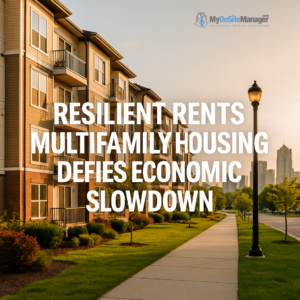 Why apartment rents are still rising even as the U.S. economy cools
Why apartment rents are still rising even as the U.S. economy cools
As economic indicators begin to flash signs of a slowdown, the U.S. multifamily housing market continues to demonstrate remarkable resilience. Despite rising interest rates, inflation pressures, and a cautious investment landscape, average apartment rents are still trending upward nationwide.
National Rent Trends Remain Strong
In April, the average multifamily rent rose by $3 to $1,725, according to data from Yardi Matrix. While this increase might seem modest, it’s the latest sign of stability in a market that many expected to cool significantly by now.
The year-over-year rent growth currently stands at 0.8%, modest but still positive. Rents have now increased for four straight months, and experts believe we may see continued slow-but-steady gains throughout the summer.
Occupancy and Supply: A Delicate Balance
Despite economic headwinds, national occupancy rates have remained fairly steady at around 94.5%. While that’s a slight decline from previous years, it’s still a strong figure considering the large number of new units hitting the market in recent months.
Many cities are seeing the effects of pandemic-era construction, with thousands of new apartments coming online. But in several metros, particularly those with limited available land or strict zoning laws, demand is still outpacing supply. This imbalance has helped keep rents buoyant.
Why Rents Are Still Climbing
A few key reasons are helping support rent growth, even in a slowing economy:
-
Persistent Housing Shortage: Homeownership remains unaffordable for many due to high mortgage rates, pushing more people toward rentals.
-
Limited Inventory in Hot Markets: Sun Belt and Midwest cities continue to attract renters thanks to job growth and lower costs of living.
-
Urban Lifestyle Revival: After a pandemic dip, more renters are returning to urban cores, boosting demand for centrally located apartments.
Investor Sentiment: Proceeding with Caution
Despite solid fundamentals, investors and developers are increasingly cautious. The rising cost of capital is reshaping the economics of new construction. Many developers are hitting pause or scaling back on projects that are no longer financially viable in today’s interest rate environment.
Additionally, economic uncertainty is pushing investors to prioritize properties in stable markets with strong job growth and low vacancy risk.
What This Means for Renters and Property Managers
For renters:
Continued rent growth—albeit slower than in 2021–2022—means budgeting remains tight. While some markets are seeing concessions or rent flattening, especially in areas with oversupply, many renters should not expect significant price relief in the near term.
For property owners and managers:
The current environment presents both opportunity and risk. Well-located, professionally managed properties are continuing to perform well, but rising costs (utilities, insurance, taxes) and delayed deliveries on construction projects remain concerns.
Final Thoughts: The Road Ahead
The multifamily sector is facing a transitional moment. As the broader economy decelerates, rental housing is proving to be a stabilizing force. Rent growth may slow, but it is unlikely to reverse dramatically unless there’s a deeper economic downturn.
The key question going forward: Will wage growth and consumer confidence hold steady enough to support ongoing rent increases? If so, landlords can expect continued gains—albeit more modest—through the rest of the year.
Source: Multifamily Rents Rise As Economy Begins To Slow – Rental Housing Journal
